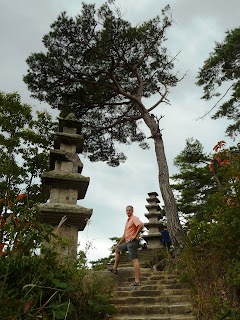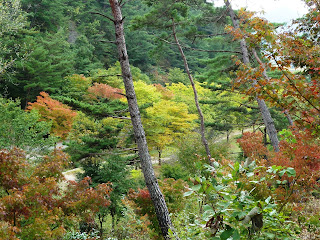Of the many temples we have visited in Korea, I most enjoyed Unjusa. It is nestled in a peaceful cozy valley about 30-minutes from the Hwasun Dolmen Site. Saturday, October 10, 2015 was the day Bob and I explored this area, and I fell in love with the calm and gentle pace of life here. I guess living amid the bustle of Seoul City for the past 4 years instills a yearning for it's opposite.
Unjusa is well-known for it's numerous Buddha statues and Pagodas. Built in the 11th century, it has been recorded that there were originally 1000 Buddhas and 100 Pagodas along the ridges of this valley. Currently, only 100 Buddhas and 21 Pagodas remain. They were easily observed as we hiked along the peaks and valleys surrounding the temple.



A few prominent features in the gardens include the Nine-tier pagoda with many geometrical shapes carved into it's body representing light; the two large Buddhas carved from a large stone lying at the top of a peak; and the two Buddhas sitting back to back inside a small roofed house. A rare multi-cylindrical pagoda; a rice-steamer pagoda which has the appearance of rice steamers piled upon one another; and a seated Buddha carved into the side of a cliff are unusual finds.
The temple site was painted with some thought-provoking scenes. I am fond of the depictions of good triumphing over evil, and the choir of 1000 Buddhas. Of course, there was the usual gong and bell for getting one's attention when needed.
Encompassed by the brilliant fall foliage, I paused for a moment of meditation, and discovered I wasn't alone!
Leaving Unjusa, we drove along country roads toward the western coast where we would visit the National Maritime Museum in Mokpo. My hunt for amazing scenes of farmlands and burial mounds was underway. What I loved most about this rural area of Korea was the model of family life pictured so completely in the land they carefully work. It was not uncommon to see homes nestled among fields of rice, glowing yellow with their ripe fall harvest, Rows of white domed greenhouses bursting with promise provide hope against the coming winter. Where fields meet hills, a family cemetery formed upon the slopes widens at it's base as generations follow their ancestors to the spirit world beyond.
Can you understand the beauty I am drawn to in these places of peace and rest?
"In a moment, in the twinkling of an eye, at the last trump: for the trumpet shall sound, and the dead shall be raised incorruptible, and we shall be changed.
For this corruptible must put on incorruption, and this mortal must put on immortality.
So when this corruptible shall have put on incorruption, and this mortal shall have put on immortality, then shall be brought to pass the saying that is written, Death is swallowed up in victory.
O death, where is thy sting? O grave, where is thy victory?
The sting of death is sin; and the strength of sin is the law.
But thanks be to God, which giveth us the victory through our Lord Jesus Christ.
Therefore, my beloved brethren, be ye steadfast, unmoveable, always abounding in the work of the Lord, forasmuch as ye know that your labour is not in vain in the Lord."
1 Corinthians 15:52-58





































































































